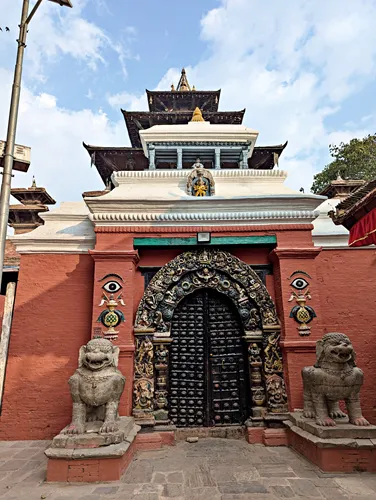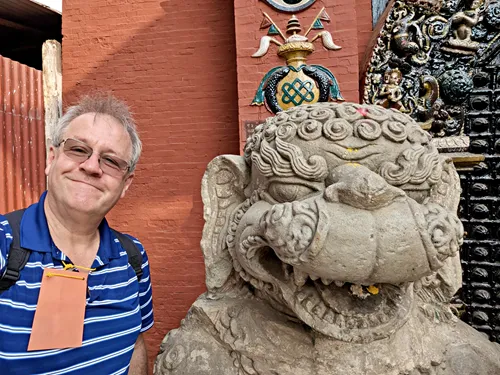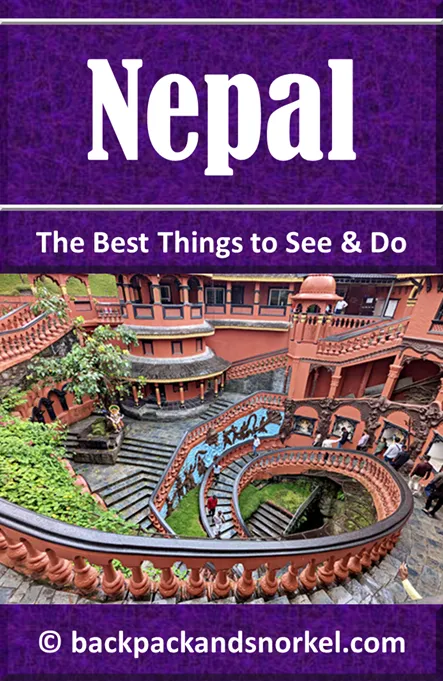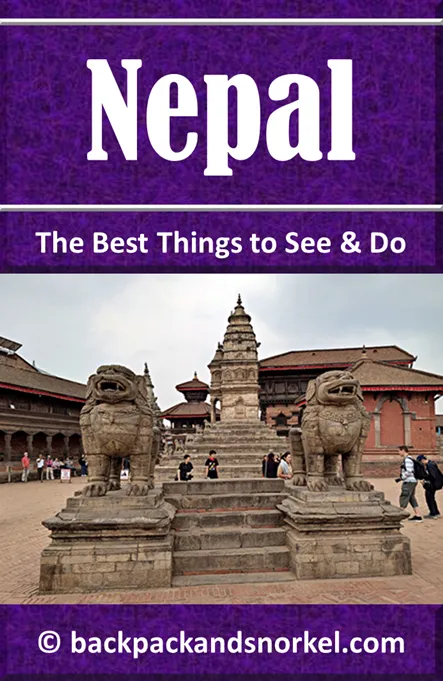Taleju Bhawani Temple: Understanding Kathmandu Durbar Square's Royal Goddess - Nepal Purple Travel Guide
(map, reviews)
This is Premium Content! To access it, please download our
Backpack and Snorkel Purple Travel GuideBehind Kageswor Mahadev Temple, you will see two smaller shrines and a gate. Behind that gate lies Taleju Bhawani Temple.
Taleju Bhawani Temple is one of the most revered landmarks in Kathmandu Durbar Square. This sacred temple is dedicated to Taleju Bhawani, a powerful protective goddess and the royal deity of the Malla kings who ruled the Kathmandu Valley for centuries.



Here at Backpack and Snorkel Travel Guides, we typically promote self-guided walking tours.
But we realize that not everybody likes to walk by themselves in a foreign city. So, just in case that you rather go with ab guide: NO PROBLEM! Please see the Viator tours below.
free GuruWalk tours
paid Viator tours
Origin of the name Taleju Bhawani Temple
The name Taleju is derived from the Hindu goddess Durga, a fierce and protective deity who battles evil and protects dharma (cosmic order), in her form as the guardian of kings and kingdoms. Taleju is often depicted as a multi-armed warrior goddess, seated on a lion or standing on a demon, holding weapons like a sword, trident, and discus. She represents the power to destroy evil and maintain justice and order.
‘Bhawani’ is a Sanskrit term meaning ‘the goddess’ or ‘the divine mother’.
Historic and Cultural Background of Taleju Bhawani Temple
According to legend, the goddess Taleju appeared in the dreams of King Mahendra Malla in the 16th century. She instructed him to build a temple dedicated to her on the condition that it be kept hidden from the public eye, accessible only to royalty and a few chosen priests. In return, she would protect his kingdom.
The resulting Taleju Bhawani Temple became the royal temple of the Malla dynasty and later the Shah dynasty, who continued her worship after unifying Nepal.
The temple was built in 1564 and remains the tallest structure in Kathmandu Durbar Square.
Another fascinating link: the tradition of the Kumari, or living goddess of Kathmandu, is believed to be inspired by Taleju herself.
Legend says that King Jayaprakash Malla used to play dice with Taleju in secret. One night, he made an inappropriate remark, angering the goddess. She vanished and promised never to return, unless she was worshipped in the form of a young prepubescent girl. That’s how the tradition of the Royal Kumari began.
The Kumari House (Kumari Ghar), also in Durbar Square, is directly tied to the worship of Taleju, and the living goddess is still brought to the Taleju Temple once a year during Dashain.
Architecture and Symbolism of Taleju Bhawani Temple
The Taleju Temple is a stunning example of Newar architecture, constructed in a three-tiered pagoda style and elevated on a massive platform. It stands taller than all the other buildings in the square, symbolizing the divine authority of the goddess over the city. The temple is adorned with intricate wood carvings, statues of mythical creatures, and golden finials, all emphasizing its sacred status.
Access and Use of the Taleju Bhawani Temple
The temple is not open to the general public throughout the year. It opens only once annually during the Dashain festival, specifically on Maha Nawami, the ninth day of Dashain. Dashain is Nepal's most important religious festival, which celebrates Durga’s victory over evil. On this day one day (Maha Nawami), members of the royal family (during the time when Nepal was still a monarchy) and devotees (nowadays only devotees) offer elaborate sacrifices and prayers.
Rituals are led by specially appointed Newar priests, often from specific hereditary families.
While visitors cannot enter the temple, it can be admired from outside the gate within Kathmandu Durbar Square.
Back to your self-guided tour
Author: Rudy at Backpack and Snorkel
Bio: Owner of Backpack and Snorkel Travel Guides. We create in-depth guides to help you plan unforgettable vacations around the world.
Other popular Purple Travel Guides you may be interested in:
Like this Backpack and Snorkel Purple Travel Guide? Pin these for later:





